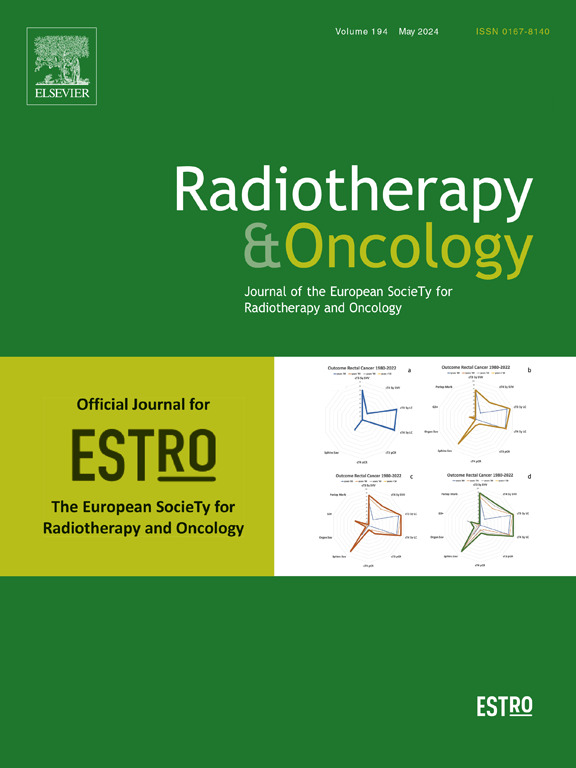通过常规血液检查预测姑息性放疗患者30天死亡率:逻辑回归和梯度增强模型的比较
IF 4.9
1区 医学
Q1 ONCOLOGY
引用次数: 0
摘要
目的本研究旨在估计姑息性放射治疗(RT)患者的30天死亡率(30D_M),并比较30D_M预测模型。材料和方法回顾性分析了2018年至2020年在两家机构接受姑息性放疗的3756例患者的数据。来自一个机构的3315名患者被随机分配到培训(N = 2652)和内部验证(N = 663)队列中。其余441名来自其他机构的患者构成外部验证队列。从医疗记录中提取了19个特征,其中包括7个血液测试特征。对于30D_M预测,构建了4个模型:包含所有特征(LRM-A)和7个血液测试特征(LRM-B)的逻辑回归模型和使用所有特征(GBM-A)和7个血液测试特征(GBM-B)的梯度增强模型。结果训练组、内部验证组和外部验证组的30D_M率分别为10.6 %、11.2 %和17.5 %。GBM-B具有较好的受者工作特征曲线下面积(AUC)值(0.830-0.863)。在4个模型中,GBM-A的AUC值最高,但GBM-B的AUC值仍普遍优于LRM-A和LRM-B。根据GBM-B预测概率的分位数值,4个预后组的30D_M率差异显著:0-0.8 %(第1分位数)、1.2-3.4 %(第2分位数)、8.7-12.9 %(第3分位数)和31.1-36.6 %(第4分位数)。结论采用GBM-B模型成功地将30D_M率划分为不同的预后组。该模型可以作为预测姑息性放疗患者死亡率的直接和客观的工具。本文章由计算机程序翻译,如有差异,请以英文原文为准。
Predicting 30-day mortality with routine blood tests in patients undergoing palliative radiation therapy: A comparison of logistic regression and gradient boosting models
Purpose
This study aimed to estimate the 30-day mortality (30D_M) and compare models for 30D_M prediction in patients undergoing palliative radiation therapy (RT).
Materials and methods
Data from 3,756 patients who underwent palliative RT between 2018 and 2020 at two institutions were retrospectively reviewed. From one institution, 3,315 patients were randomly assigned to the training (N = 2,652) and internal validation (N = 663) cohorts. The remaining 441 patients from the other institution constituted the external validation cohort. Nineteen features, including seven blood test features, were extracted from medical records. For 30D_M prediction, 4 models were constructed: logistic regression comprising all features (LRM-A) and 7 blood test features (LRM-B) and gradient boosting using all features (GBM-A) and 7 blood test features (GBM-B).
Results
The 30D_M rates were 10.6 %, 11.2 %, and 17.5 % in the training, internal validation, and external validation cohorts, respectively. GBM-B demonstrated a good value for the area under the receiver operating characteristic curve (AUC) (0.830–0.863). Among the four models, GBM-A exhibited the highest AUC values, although GBM-B still generally outperformed LRM-A and LRM-B. The 30D_M rates significantly differed across the four prognostic groups according to the quantile values of predictive probability of GBM-B: 0–0.8 % (1st quantile), 1.2–3.4 % (2nd quantile), 8.7–12.9 % (3rd quantile), and 31.1–36.6 % (4th quantile), respectively.
Conclusions
The 30D_M rates were successfully stratified into distinct prognostic groups by using the GBM-B model. The model could serve as a straightforward and objective tool for predicting mortality in patients undergoing palliative RT.
求助全文
通过发布文献求助,成功后即可免费获取论文全文。
去求助
来源期刊

Radiotherapy and Oncology
医学-核医学
CiteScore
10.30
自引率
10.50%
发文量
2445
审稿时长
45 days
期刊介绍:
Radiotherapy and Oncology publishes papers describing original research as well as review articles. It covers areas of interest relating to radiation oncology. This includes: clinical radiotherapy, combined modality treatment, translational studies, epidemiological outcomes, imaging, dosimetry, and radiation therapy planning, experimental work in radiobiology, chemobiology, hyperthermia and tumour biology, as well as data science in radiation oncology and physics aspects relevant to oncology.Papers on more general aspects of interest to the radiation oncologist including chemotherapy, surgery and immunology are also published.
 求助内容:
求助内容: 应助结果提醒方式:
应助结果提醒方式:


